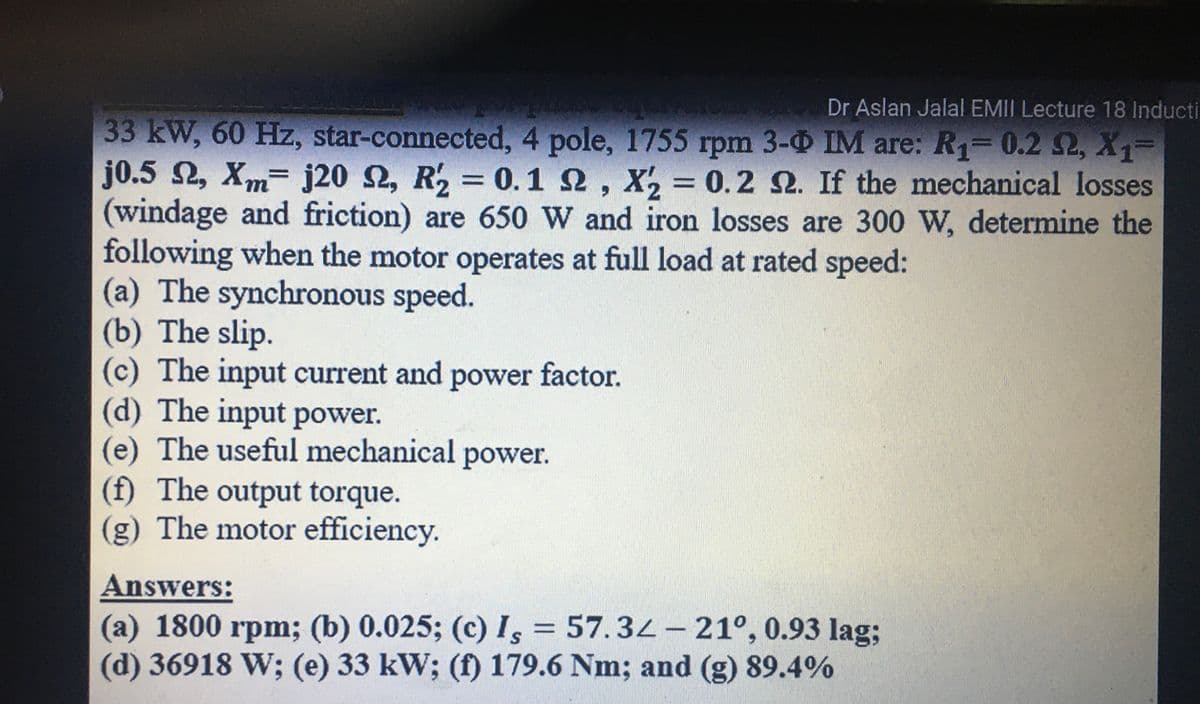Dr Aslan Jalal EMII Lecture 18 Indur 33 kW, 60 Hz, star-connected, 4 pole, 1755 rpm 3-0 IM are: R1= 0.2 S2, X1= j0.5 2, Xm= j20 2, R2 = 0.1 2, X, = 0.2 2. If the mechanical losses (windage and friction) are 650 W and iron losses are 300 W, determine the following when the motor operates at full load at rated speed: (a) The synchronous speed. (b) The slip. (c) The input current and power factor. (d) The input power. (e) The useful mechanical power. (f) The output torque. (g) The motor efficiency. Answers: (a) 1800 rpm; (b) 0.025; (c) I, = 57.34 – 21°, 0.93 lag; (d) 36918 W; (e) 33 kW; (f) 179.6 Nm; and (g) 89.4%
Dr Aslan Jalal EMII Lecture 18 Indur 33 kW, 60 Hz, star-connected, 4 pole, 1755 rpm 3-0 IM are: R1= 0.2 S2, X1= j0.5 2, Xm= j20 2, R2 = 0.1 2, X, = 0.2 2. If the mechanical losses (windage and friction) are 650 W and iron losses are 300 W, determine the following when the motor operates at full load at rated speed: (a) The synchronous speed. (b) The slip. (c) The input current and power factor. (d) The input power. (e) The useful mechanical power. (f) The output torque. (g) The motor efficiency. Answers: (a) 1800 rpm; (b) 0.025; (c) I, = 57.34 – 21°, 0.93 lag; (d) 36918 W; (e) 33 kW; (f) 179.6 Nm; and (g) 89.4%
Power System Analysis and Design (MindTap Course List)
6th Edition
ISBN:9781305632134
Author:J. Duncan Glover, Thomas Overbye, Mulukutla S. Sarma
Publisher:J. Duncan Glover, Thomas Overbye, Mulukutla S. Sarma
Chapter2: Fundamentals
Section: Chapter Questions
Problem 2.1P: Given the complex numbers A1=630 and A2=4+j5, (a) convert A1 to rectangular form: (b) convert A2 to...
Related questions
Question

Transcribed Image Text:Dr Aslan Jalal EMII Lecture 18 Inducti
33kW, 60 Hz, star-connected, 4 pole, 1755 rpm 3-0 IM are: R1= 0.2 S2, X1=
j0.5 2, Xm= j20 2, R, = 0.1 N , X, = 0.2 2. If the mechanical losses
(windage and friction) are 650 W and iron losses are 300 W, determine the
following when the motor operates at full load at rated speed:
(a) The synchronous speed.
(b) The slip.
(c) The input current and power factor.
(d) The input power.
(e) The useful mechanical power.
(f) The output torque.
(g) The motor efficiency.
%3D
Answers:
(a) 1800 rpm; (b) 0.025; (c) I, = 57.34– 21°, 0.93 lag;
(d) 36918 W; (e) 33 kW; (f) 179.6 Nm; and (g) 89.4%
Expert Solution
This question has been solved!
Explore an expertly crafted, step-by-step solution for a thorough understanding of key concepts.
Step by step
Solved in 4 steps with 4 images

Knowledge Booster
Learn more about
Need a deep-dive on the concept behind this application? Look no further. Learn more about this topic, electrical-engineering and related others by exploring similar questions and additional content below.Recommended textbooks for you

Power System Analysis and Design (MindTap Course …
Electrical Engineering
ISBN:
9781305632134
Author:
J. Duncan Glover, Thomas Overbye, Mulukutla S. Sarma
Publisher:
Cengage Learning


EBK ELECTRICAL WIRING RESIDENTIAL
Electrical Engineering
ISBN:
9781337516549
Author:
Simmons
Publisher:
CENGAGE LEARNING - CONSIGNMENT

Power System Analysis and Design (MindTap Course …
Electrical Engineering
ISBN:
9781305632134
Author:
J. Duncan Glover, Thomas Overbye, Mulukutla S. Sarma
Publisher:
Cengage Learning


EBK ELECTRICAL WIRING RESIDENTIAL
Electrical Engineering
ISBN:
9781337516549
Author:
Simmons
Publisher:
CENGAGE LEARNING - CONSIGNMENT